#Supreme Court on farm laws
Explore tagged Tumblr posts
Note
(sorry this is from a week ago but) Wait, what's going on right now that's complicated with Amazonian farmers' land rights?
Not farmers, indigenous people
See, recently they put a new law through congress that severely reduces indigenous land to the borders established during the late dictatorship, or immediately post-dictatorship, in 1988. An absolute joke of a border that was dreamed up by some military assholes. People in america may recognize this type of society from the times of westward expansion and think this is a thing of the past because for you guys it is. But here it is a reality. Murder is rampant. The reach of the law is incredibly limited. Government is just too weak and landowners basically run things. THAT'S WHY it's so important to donate directly to the native peoples instead of random NGOs because native people are fucking there and the more power they hold in the land the safer the land will be from agroindustrial expansion.
Well the law was vetoed by the the president and the Supremo Tribunal Federal, aka supreme federal court, labeled it as unconstitutional. Which it is, because our 1988 constitution describes native american land rights in some of its first articles. We thought this would be it for the law
But then the senate (that already overrepresents landowners in rural states) just went along and approved it anyway. I had no idea they could approve something unconstitutional. The progressives and particularly the socialists are fighting this in court. But it happens that for now the legal border is the severely reduced version.
Doesn't mean they'll just give up, because as it happens we don't have any stand your ground laws so even if you own a piece of land, you cannot legally speaking just shoot everyone there. Or attack or threaten them in any way. They'll just have long legal battles individually for the rights to occupy land based on use. Also the Xingu national park, the largest preserved land of the Amazon described as 'larger than Belgium', is being encroached by huge farms that are poisoning their water supply. The border is Visible. I'll try to find video of it but essentially you have a forest and a desert separated by a strict line.
Just last week in the south of Bahia (not the Amazon, let me explain more about the Amazon situation in a bit) Hãhãhãe leadership Nega Muniz Pataxó was shot and killed by an armed militia group that invaded and occupied the Caramuru territory.
instagram
The situation in the Amazon, specifically the yanomami territory in Roraima our northernmost state, aka deep forest, is more dire than average given difficulty of access, sheer size, and government abandonment. It's a place that depends on government aid for medicine. It's land that is being systematically invaded by gold miners, pandemic, toxins from nearby farmlands, wood extraction etc. (wood extration is rampant everywhere tho). Early 2023 saw a massive federal government operation by now president Lula to empty the mines and try to look for where funding comes from. Yanomami land is still being invaded to this day, the struggle is ongoing.
The yanomamis need support right now more than any other. Last year saw a massive heat wave that (well, one, caused a girl named Ana Clara Machado to die during the Taylor Swift concert. This is unrelated but I feel like not enough foreign media covered this, Taylor even lied about it as well.) dried up a lot of rivers, killed a LOT of fresh water animals including an unprecedented amount of pink dolphins. Access that was already hard became damn near impossible without boats. I cannot overstate how many pink dolphins were found dead.
Another technique that landowners use to clear space for farms is to just set things on fire and then occupy the empty land, which they legally can do to land that was naturally burned in a forest fire. It happened that Pantanal, another national park of swampland, was massively devastated by fires last year too
this article is from 2020, the year that the worst fire happened, but in 2023 there was another one. It's been happening yearly now due to a) deliberate action and b) climate change aggravation.
And this is not nearly all. Just off the top of my head. If you speak portuguese I recommend following the APIB or the COIAB on instagram to keep up with the news. The FUNAI is the government branch of indigenous organization, but it's not generally that well liked. Still.
807 notes
·
View notes
Text
Long Post... But Very Important 👇
HISTORY OF THE US NESARA LAW:
· NESARA was signed into law by President William Jefferson Clinton in 2000, at gunpoint because the Military forced him to sign it. He wasn't going to, and was to be announced by Alan Greenspan on Sept. 11, 2001, at 10:00am.
· This was prevented by the destruction of the World Trade Center by then President George W. Bush, Dick Cheney and others involved with this great deception. They murdered 7,000 innocent Americans that day and stole billions in Gold and Silver from Building 7.
· In early 1993, the U.S. Supreme Court ruled on charges by the Farmer's Union that banks in the U.S. were fraudulently foreclosing on farm mortgages and that the U.S. Government was in collusion with these banks. The testimony and proof brought into court by a retired CIA Agent let to further evidence and proof that Farmer's Union claims were legitimate. It also led to evidence that the 16th Amendment, the Income Tax Amendment, was never properly ratified by the required number of states and therefore, declared that income taxes were unlawful.
· Almost unanimously the U.S. Supreme Court Justices ruled in favor of Farmer's Union. The Justices recognized that overwhelming evidence proved the U.S. Government and the Federal Reserve Banking System were perpetrating FRAUD in many ways upon Americans. The Justices recognized that to remedy this situation, massive reformations would be required. When rulings were made by the U.S. Supreme Court, one or more of the justices are assigned to monitor the process by which rulings are carried out.
· In this case, five of the Justices were assigned to a committee to develop steps to implement the required governmental and banking reformations. As the Justices went about developing the changes, they enlisted the help of experts in Economics, Monetary Systems, Banking, Constitutional Law and other areas. They built coalitions of support and assistance with thousands of people worldwide, working with us to bring NESARA and GESARA to fruition. These people were called the "White Knights". The term "White Knights" was borrowed from the world of big business when a vulnerable company is "rescued" from a hostile takeover.
· Because of the enormously sweeping changes the rulings by the U.S. Supreme Court required, an EXTREMELY STRICT gag order was put in place on everyone involved. The Justices also sealed all records on the case until after the reformations are all accomplished.
· To maintain secrecy, the case details for the docket number assigned to the Farmer's Union case were changed. So, doing a search for this case will fail to reflect the correct information until after the reformations are made public. At every step of the process, anyone directly involved has been required to sign an NDA to keep the process of implementing the required reformations "Secret" or face charges of Treason which are punishable by death.
· To implement the reformations, the five justices spent years negotiating how the reformations would occur in agreements called "accords" with the U.S. Government, with Federal Reserve Bank owners, the IMF, World Bank, and numerous countries including the UK and the EU.
· The reformations required the Federal Reserve Bank system to be absorbed by the U.S. Treasury and all fraudulent banking activities to be stopped, as well as remedies to Americans for past harm due to FRAUD.
· The U.S. Banking reformations will impact the entire world and therefore the IMF, World Bank and other countries involved including the UK and the Vatican City.
· Members of Congress were ordered by U.S. Supreme Court to "DENY" the existence of NESARA / GESARA or face charges of TREASON, punishable by DEATH. Some members of Congress were charged with "Obstruction" and threatened with charges of TREASON. Therefore, all members of U.S. Congress have had to pretend that NESARA has not been passed in order to comply with the Justice's GAG ORDER.
O. SAT. 3 AUGUST 2024 NESARA GESARA REFORMATIONS:
· NESARA / GESARA is the most groundbreaking reformations to sweep the world in the entire history of the world.
· All foreigners will be required to return home in order for them to receive their GESARA Payments.
NESARA DOES THE FOLLOWING: 👇
a. Zero's out all Credit Card, Mortgage and other bank and loan transaction debts.
b. Abolishes the Internal Revenue Service and the Income Tax.
c. IRS employees will be transferred to the US Treasury National Sales Tax area.
d. The Federal Reserve will be absorbed into the US Treasury.
e. Creates a 14% - 17% National Sales Tax, applied to NEW ITEMS only for government revenue. Some of it goes to states, rest to new national government.
f. Used items sold will not be taxed. Food & Medicines will not be taxed.
g. Sets up Restitution Payments for those victimized by Chattel Property Bonds. Those Aged 61 and over will receive a lump sum payment. Those Aged 41 to 60 will receive scheduled payments set time and sign work contract. Those Aged 29-40 will have to sign a Work Contract to receive their funds. Initiates a Universal Basic Income or UBI for those 16-29 years old.
h. An increase for retired Senior Citizens up to 3x current SSN amount up to $5,000.00
i. Dissolves US Inc. and returns the country to 1791 Constitution and Common Law.
J. Admiralty-Equity & Civil Laws are dissolved. Judges & Lawyers will be retrained in Constitutional Law.
k. Restores the Original 13th Amendment known as the Titles of Nobility Amendment.
l. Requires that New Presidential and Congressional Elections occur within 120 days.
m. Monitors Elections and prevents illegal election activities of everyone.
n. Creates a new US Treasury Rainbow Currency that is Asset Backed.
o. Forbids the sale of American Birth Certificates as chattel property bonds.
p. Initiates a new US Treasury Banking System in alignment with Constitutional Law.
q. Restores Personal Financial Privacy.
r. Ceases All Military Activities Worldwide.
s. Establishes World Peace.
t. Releases enormous sums of money to be used for Humanitarian Purposes.
u. Enables the release of over 6,000 patents of suppressed technologies including free energy devices, anti-gravity and medical bed technologies.
THE RODRIGUEZ TRUST REDEMPTION AND EXCHANGE FUNDING PROGRAM: 👇
· The Rodriguez Trust, based in the Philippines, is reportedly over 100 years old. It is claimed to be the single largest source of funds in the world.
· Dr. Alan Cohler is said to be the asset manager of the trust. The trust is backed by gold, some of which is said to come from King Solomon’s Temple.
· However, these claims are often associated with spiritual and metaphysical beliefs, and their validity is not universally accepted. For definitive information, legal consultation is recommended.
· The value of both the St. Germain and Rodriguez Trusts have 3083 zeros behind them.
The "New Earth" is near 🤔
#pay attention#educate yourselves#educate yourself#knowledge is power#reeducate yourself#reeducate yourselves#think about it#think for yourselves#think for yourself#do your homework#do your own research#do some research#do your research#ask yourself questions#question everything#nesara#new earth#new life#coming soon
115 notes
·
View notes
Text
The Best News of Last Week - March 27, 2023
🐢 - Why did the 90-year-old tortoise become a father? Because he finally came out of his shell!
1. New Mexico governor signs bill ending juvenile life sentences without parole

New Mexico Governor Michelle Lujan Grisham has signed a bill into law that prevents juvenile offenders from receiving life sentences without eligibility for parole. The bill, known as the No Life Sentences for Juveniles Act, allows offenders who committed crimes under the age of 18 and received life sentences to be eligible for parole hearings 15 to 25 years into their sentences.
This legislation also applies to juveniles found guilty of first-degree murder, even if they were tried as adults. The move puts New Mexico in a group of at least 24 other states and Washington, DC, that have enacted similar measures following a 2021 Supreme Court ruling.
2. Promising pill completely eliminates cancer in 18 leukaemia patients

An experimental pill called revumenib has shown promise in curing terminal leukemia patients who were not responding to treatment in a long-awaited clinical trial in the United States. The drug works by inhibiting a specific protein called menin, which is involved in the machinery that gets hijacked by leukemia cells and causes normal blood cells to turn into cancerous ones.
The pill targets the most common mutation in acute myeloid leukemia, a gene called NPM1, and a less common fusion called KMT2A. The US Food and Drug Administration granted revumenib "breakthrough therapy designation" to fast-track its development and regulatory review based on the promising results of the trial.
3. Spain passes law against domestic animal abuse

Spain has passed a new law on animal welfare, accompanied by a reform of the penal code that increases prison sentences for those mistreating animals. The law will make compulsory training for dog owners, and will prohibit them from leaving their dogs alone for more than 24 hours.
It also mandates the sterilisation of cats, with exceptions for farms, and increases the penalties for mistreatment of animals to up to two years in prison, or three years in the event of aggravating circumstances.
4. Bravery medals for women who raced into 'rough, crazy' surf to save drowning girls

Elyse Partridge (far left) and Bella Broadley (far right) raced into dangerous surf to save Chloe and Violet from drowning.(ABC North Coast: Hannah Ross)
Bella Broadley and Elyse Partridge saved two 11-year-old girls from drowning at Angels Beach near Ballina, an unpatrolled beach in Australia. The younger girls, Chloe and Violet, became trapped in a rip and overwhelmed by waves and the current. Bella and Elyse jumped into action, using an esky lid as a flotation device to help them swim to the girls. Elyse helped Chloe back to shore while Bella swam further out to help Violet.
Elyse and Bella were on Wednesday named on the Governor General's Australian Bravery Decorations Honours List, which recognised 66 Australians for acts of bravery.
5. Almost every cat featured in viral Tik Tok posted by Kansas City animal shelter adopted
Let's find homes for the rest
youtube
6. A 90-year-old tortoise named Mr. Pickles just became a father of 3. It's a big 'dill'

These critically endangered tortoises are native to Madagascar and have seen their numbers decline due to over-collection for illegal sales on the black market. Captive breeding programs have helped produce new radiated tortoises, but the species still faces extinction in the wild.
That's why the arrival of these hatchlings, born to 90-year-old Mr. Pickles and his 53-year-old partner Mrs. Pickles, is such great news. Mr. Pickles is considered the most genetically valuable radiated tortoise in the Association of Zoos and Aquariums' Species Survival Plan, and the births represent a significant contribution to the survival of the species.
7. EU strikes ‘ground-breaking’ deal to cut maritime emissions

The European Parliament and EU ministers have agreed on a new law to cut emissions in the maritime sector. The law aims to reduce ship emissions by 2% as of 2025 and 80% as of 2050, covering greenhouse gas, methane, and nitrous oxide emissions.
The European Commission will review the law in 2028 and will decide whether to place carbon-cutting requirements on smaller ships. The agreement will also require containerships and passenger ships docking at major EU ports to plug into the on-shore power supply as of 2030. Penalties collected from those that fail to meet the targets will be allocated to projects focused on decarbonising the maritime sector.
- - - -
That's it for this week :)
This newsletter will always be free. If you liked this post you can support me with a small kofi donation:
Buy me a coffee ❤️
Also don’t forget to share this post with your friends.
467 notes
·
View notes
Note
Dear Chronivac Support
Our prison system in california is overstrained and really expensive for the people financing it. So we from law enforcement are looking for alternatives making bad guys to good ones serving the community. Is there a way for a collaboration testing the system on maybe 2 really bad inmates transforming them to good ones working in solid jobs, going back to college or something in this direction?
The whole thing was anything but simple. But we coordinated it with the Department of Justice and the California Supreme Court. On a transitional basis, Chronivac TFs can replace jail time. The following conditions must be met:
No use in homicides No use for aggravated and dangerous assault No use in security detention for mental disorders The TF must be humiliating The TF must be recognizable to the social environment of the offender. TF must be beneficial to society The offender must not derive any benefit from the TF after it has ended
There are three trial cases, if successful, the operation can be expanded.

Mike and Gary were accused of being members of a terrorist organization. Both belonged to an extreme left-wing circle that planned various attacks on infrastructure. The TF of the two begins during a meeting of the association. While everyone else is lounging around in their chairs, the two suddenly stand at attention. Their long and unkempt hair becomes fresh buzz cuts And the stubble beards become freshly shaved chins. You begin and end every sentence with "Sir". And they begin to talk only of law and order. Their scruffy hippie clothes become bright white and freshly ironed. Their comrades start calling them reactionary assholes. They call their former friends associative riffraff. The two leave the building to the jeers of their former friends. Over the next few weeks, you will work as good Marines with uncovering all of their plans.

These three are in jail for drug trafficking, weapons trafficking, and receiving stolen property. When the TF is started, they are just pumping with their buddies. Suddenly, their gym IDs become street cleaning IDs. And their muscles disappear. What's left behind are puny youngsters. In hi-viz clothing. Their show-off cars have become a garbage truck. None of their customers or business partners will take them seriously again, if they ever get back into business.

These two were Masters of the Universe before prison. Filthy rich investment bankers. Unfortunately, you did tax evasion on a very large scale yourself and for your clients.

Now they live in a trailer park and repair farm equipment when they're not wrenching on their monster trucks.

Your idea was really good, bro. Now it just has to prove itself in practice. Let's see if I can report on other cases soon.
185 notes
·
View notes
Text
Excerpt from this story from the New York Times:
For years, politicians, industry groups and environmentalists have argued over which bodies of water in the United States should fall under the jurisdiction of the Clean Water Act, a sweeping law, passed in 1972, that allows the Environmental Protection Agency to limit water pollution. While there’s consensus that the law applies to major rivers and lakes, there’s debate over whether federal protections should apply elsewhere, such as to nearby wetlands or streams that go dry for part of the year.
Environmentalists favor broad protections, arguing that these other bodies of water are important; homebuilders, some industry groups and conservatives oppose what they see as regulatory overreach.
In May 2023, the Supreme Court voted 5 to 4 to restrict the scope of the Clean Water Act, with the majority ruling that the law should apply only to “relatively permanent, standing or continuously flowing bodies of water,” as well as to wetlands that have “a continuous surface connection” to those waters.
That ruling effectively ended federal protections for up to 4.9 million miles of streams that flow only when it rains, according to officials at the E.P.A., which announced in August that it would follow the court’s guidance.
These temporary streams are often overlooked since they may look like unremarkable dry ditches for much of the year, said Jud Harvey, a senior research hydrologist for the United States Geological Survey, who wrote a separate commentary on the Science study. “But when it rains,” he said, “these streams convey a substantial amount of water” that ends up in rivers and lakes.
Mr. Brinkerhoff and his colleagues identified millions of ephemeral streams across the country and used detailed modeling to estimate how much water flows through them.
In the West, ephemeral streams flow only for four to 46 days per year on average, but contribute up to 79 percent of the downstream river flow, the study found. Ephemeral streams contribute roughly 55 percent of the flow in river basins across the contiguous United States, on average.
Mr. Harvey said he was surprised by the amount of water originating from ephemeral streams. “But it is a rigorous and detailed investigation using the best available data in the United States,” he said of the study.
Because so much water passes through these streams, the study notes, it matters greatly whether or not they are polluted. Sediments or excess phosphorus from fertilizer run off on farms could accumulate in dry channels until a heavy rainstorm picks up the pollutants and washes them into larger waterways.
Mr. Brinkerhoff said that the study did not try to quantify how much pollution was actually passing through those streams. That is a subject for future research. But, he said, these streams have a large influence on water quality.
29 notes
·
View notes
Text
January 20, 2025
POTUS:
Retracted 78 previous executive orders, most regarding COVID-19 actions to ensure public safety, federal DEI programs, several EOs that held the executive branch accountable, climate change, immigration, and healthcare. Full list here.
Announced Cabinet picks: here
Required all federal employees to terminate remote working
Declared a national emergency on the southern border
Removed the US from WHO and the Paris Climate Agreement
Pardoned rioters from the January 6th Insurrection
Imposed new trade standards, supposedly prioritizing America: here
Declared a national energy emergency, ignoring many environmental regulations to lower the cost of energy and promote energy production
Gave the president the ability to remove Career Senior Executives who are deemed to have "failed" the president
Bolstered the death penalty
Signed an EO to stop birthright citizenship
Signed an EO to redefine the two sexes and stated the federal government will not recognize gender identity
Implemented the Department of Government Efficiency (DOGE)
Allowed natural gas fracking and drilling in Alaska again
Several EOs were signed to prevent immigration from the southern border
Temporarily ending offshore wind farm projects
Redistributed foreign aid
Ended government DEI programs and insist the government will be hiring on merit
Federally renamed the Gulf of Mexico to the Gulf of America and Mount Denali to Mount McKinley
Designated international cartels as global terrorists
Ended national emergency that imposed sanctions on settlers invading the West Bank
More details and the actual policies can be found here
SCOTUS:
The Supreme Court was closed
Congress:
2 bills were introduced: One meant to repeal the Protecting Americans from Foreign Adversary Controlled Applications Act. The other deals with a nuance finance issue.
Passed the Laken Riley Act, requiring aliens who are being charged with theft in the US to be taken into custody
Confirm the nomination of Marco Rubio for Secretary of State
Debate began on the Born-Alive Abortion Survivors Protection Act in the Senate. The law is meant to prevent healthcare professionals from failing to provide proper care in case a child survives an abortion
In the House of Representatives, 12 public bills were introduced: 5 were regarding the Internal Revenue Code of 1986, which deals with taxes. One was to advance the US strategy in the Pacific Islands. H. R. 563 is meant to discontinue the collection of records for discontinued firearms sales by the federal government. Others dealt with the law banning TikTok, residency requirements of officials, air pollution, labor representation, and funding for law enforcement to deal with auto theft
Further details can be found here
#us politics#president trump#congress#supreme court#potus#scotus#politics#us supreme court#us president
8 notes
·
View notes
Text
Right-wing dark money activist Leonard Leo launches $1BN crusade to "‘crush" liberal America

Alex Rogers at Financial Times:
The conservative activist who led the crusade to overhaul the US legal system is making a $1bn push to “crush liberal dominance” across corporate America and in the country’s news and entertainment sectors. In a rare interview, Leonard Leo, the architect of the rightward shift on the Supreme Court under Donald Trump, said his non-profit advocacy group, the Marble Freedom Trust, was ready to confront the private sector in addition to the government. “We need to crush liberal dominance where it’s most insidious, so we’ll direct resources to build talent and capital formation pipelines in the areas of news and entertainment, where leftwing extremism is most evident,” Leo told the Financial Times. “Expect us to increase support for organisations that call out companies and financial institutions that bend to the woke mind virus spread by regulators and NGOs, so that they have to pay a price for putting extreme leftwing ideology ahead of consumers,” he said.
Leo has spent more than two decades at the influential Federalist Society, guiding conservative judges into the federal courts and the Supreme Court itself. In 2018, conservative justice Clarence Thomas joked that Leo was the third most important person in the world. Leo’s efforts culminated under Trump’s presidency, when three Federalist Society-backed judges were appointed to give conservatives on the Supreme Court a 6-3 supermajority, and profound influence over US law. The court has since then ruled to overturn the right to an abortion, among other long-sought rightwing causes. In 2020, after Trump lost the election, Leo stepped back from running the daily operations of the Federalist Society, while remaining its co-chair. The following year, Leo founded Marble, with a $1.6bn donation from electronic device manufacturing mogul Barre Seid, to be a counterweight to what he said was “dark money” of the left. He spent about $600mn in its first three years, according to public financial disclosures.
Leo said his goal was to find ���very leveraged, impactful ways of reintroducing limited constitutional government and a civil society premised on freedom and personal responsibility and the virtues of western civilisation”. The $1bn money machine is now funding the conservative mission against private institutions, opposing diversity, equity and inclusion policies, climate and social concerns in investing and the “debanking” of politically conservative customers, in addition to taking on the public sector. The non-profit is increasingly interested in launching campaigns against “woke” banks and China-friendly companies involved in everything from food production to autonomous vehicles in the US and potentially Europe. Leo also intends to invest in a US local media company in the next 12 months, although he has not decided which, and is building conservative coalitions through groups such as Teneo Network, a club with chapters across the country. He also confirmed that Marble had since 2021 helped fund organisations that launched campaigns against companies with DEI, ESG and other initiatives, including BlackRock, Vanguard, American Airlines, Coca-Cola, State Farm, Major League Baseball and Ticketmaster.
The Financial Times interviewed right-wing dark money activist Leonard Leo, as he announced plans to launch a $1BN crusade to "‘crush" liberal America.
Leo has hinted that he’ll invest in an unnamed American media company within the next year.
19 notes
·
View notes
Text

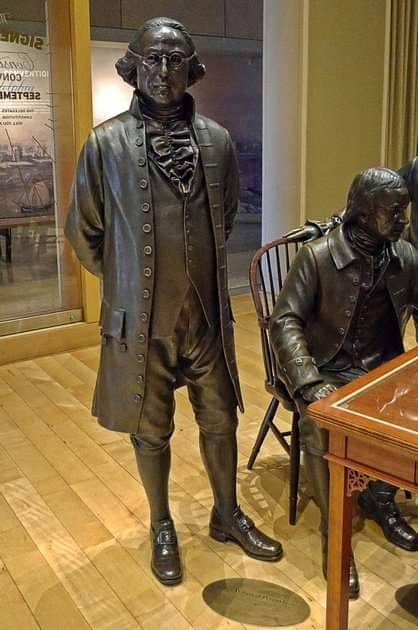

August 21st 1798 saw the death of James Wilson, one of the Founding Fathers of the United States and a signatory of the United States Declaration of Independence and the United States Constitution.
Wilson was born on September 14th 1742 at Carskerdo,Farm, near Ceres, the fourth of the seven children of Alison Landall and William Wilson, a Presbyterian farming family.
He attended the Universities of St.Andrews, Glasgow, and Edinburgh. He never finished his studies, as he sailed for the New World in 1765. Aided by some letters of introduction, he became a tutor with the College of Philadelphia. He received an honorary M.A. shortly thereafter. In November 1767, he was admitted to the bar, and thus pursuing his recent-born interest in the law. He set up his own practice in Reading in the year 1768. He was quite successful, as he handled nearly half of the cases charged in the country court.
In 1774, he wrote an essay with the title:“ Considerations on the Nature and Extent of the Legislative Authority of the British Government.” He distributed this article among the members of the First Continental Congress. Within those pages, he set down a number of arguments which severely challenged the parliamentary authority over America. In the final conclusion of this manuscript, he states that Parliament had no power whatsoever over the American colonies. Although he accepted in some ways the power of the Monarch, he would not subject himself to the whims of Parliament, in which the colonies had no representation. His manuscript was read in both America and England, and created quite a stir. He was one of the first to ever voice these opinions in a sensible, well-argumented manner.
As a member of the Pennsylvanian Provincial Congress, he made a passionate speech about the possibility of an unconstitutional act made by Parliament. Judicial Review, the American system of checking governmental acts with the Constitution, was on its way.
In the same year, 1775, he signed the Declaration of Independence as a member of the Second Continental Congress. According to sources, it seems he hesitated at first, but signed anyway. This was due to the fact that he was a representative of the Middle States, where opinions about independence differed. But by signing the Declaration, he broke the deadlock the Pennsylvania delegation was in. His signature made sure Pennsylvania voted for independence.
During the next years he was an occasional member of the Continental Congress, and was present at the Constitutional Convention of 1787, which assembled with the purpose of drafting The Constitution of the United States of America. Here he was a very influential figure, whose ideas where heavily incorporated in one of the most important documents in history. Thus the Constitution bears his signature.
In 1789, he became a professor of law at the University of Pennsylvania, and in the same year was appointed associate justice of the Supreme Court.
It’s not all good news on this Scottish born American though, he was a terrible businessman and he took flight to escape imprisonment for debt. Eventually his $197,000 debt sent him to jail twice, but only for short stays. This didn’t seem to have affected his duties as a judge though as he continued on the Federal judicial circuit despite his misdemeanors.
In 1798, James Wilson suffered a bout of malaria and then died of a stroke at the age of 55, he was buried in the Johnston cemetery on Hayes Plantation near Edenton, but was later reinterned in 1906 at Christ Churchyard, Philadelphia.
10 notes
·
View notes
Text
Eighty-three-year-old Corine Woodson is poised to suffer a devastating blow: the loss of the home she shared with her late husband—who died in 2022—for over 60 years.

Her land, 40 acres set amid rolling pines outside of Auburn, Ala., was purchased in 1911 and passed down through generations, a rare example of Black land ownership in the Deep South. But in recent years, this once rural property, now parsed out among various family members in a form of ownership known as “tenants in common,” has caught the attention of investors who hope to purchase and develop properties they consider prime real estate.
Cleveland Brothers Incorporated bought out Woodson’s relatives, accumulating 49% ownership of the previously Black-owned property. Now, the case is making news as it heads toward the Alabama Supreme Court, with the company declaring that it will suffer “financial harm” if Woodson delays the sale of her share. (A representative of Cleveland Brothers told WTVM that Woodson could stay on the property for a year even if the sale goes through.)
Soon, Cleveland Brothers will probably purchase the remaining property, displacing Woodson. “It’s happening right before our eyes,” Melissa Woodson, Corine’s daughter and a licensed realtor said, “and the sad thing is that there is very little we can do about it.”
Stories like Woodson’s have been common for Black residents of the rural South for more than a century. The continuation of patterns of Black land dispossession exposes how—for all of the civil rights gains made over the last 60 years—there is still much to be done to secure racial equality in the U.S.
At the turn of the 20th century, Black landowners owned and operated 890,000 farms. Around midcentury, however, that number began to decline sharply. Beginning in 1950, they lost more than half a million farms; by 1970, only 45,000 remained. During the 1960s alone, the Black farm count in 10 southern states dropped by 88%.
Read More: The Forgotten School Integration Story that Challenges What We Think We Know
This drop off reflected how, for decades, wealthy white people utilized the power they held in their communities as government officials and business owners to push local Black people off land that their families had lived on for generations. Local white people also exploited new laws and subsidies to remove landowners or renters, deploying what an Emergency Land Fund report in 1974 described as, “a great deal of chicanery.” New capital-intensive farming practices also favored the wealthy, while industrial development led to corporate interest in rural tracts, driving up prices.
Rural Black women were particularly vulnerable to these threats of dispossession. Take Susie Young, for instance. Within two weeks of the death of her husband in 1955, Young received notice from the Allison Lumber Company that she had to vacate the land her family rented from them and had tended for over 20 years in Choctaw County, Ala. They considered her now incapable of maintaining the property.
One Black Perry County, Ala., woman had a similar experience. After the death of her mother in the 1950s, a nearby white landowner returned to claim the 60 acres her parents had bought decades prior claiming he “didn’t sell [her] that land.” Though the family retained counsel and provided proof of purchase, they were nevertheless pushed off their land. Black landowners often lacked formal deeds, and white judges frequently ruled against their claims.
Even as the Civil Rights Act of 1964 and the Voting Rights Act of 1965 afforded Black Americans new opportunities and greater equality in many areas of life, these laws didn’t address land loss. In fact, the 1960s introduced a massive contradiction: at the same moment Black Americans achieved political gains, they were also experiencing a quiet economic catastrophe, the result of what historian Pete Daniel calls “intended consequences.”
Of course, civil rights organizations recognized the impact of Black land loss, not only for landowners but also for sharecroppers and tenant farmers. The Student Nonviolent Coordinating Committee (SNCC), the Congress of Racial Equality (CORE), Federation of Southern Cooperatives (FSC), and regional groups, such as the Southwest Alabama Farmers Cooperative Association (SWAFCA), pushed back against white structural control and assisted Black people facing displacement.
They understood that resistance to economic exploitation was inextricably intertwined with the civil rights movement’s racial justice initiatives. In 1968, for instance, the United States Commission on Civil Rights (USCCR) conducted an investigation of land dispossession in Alabama’s Black Belt. The Commission found that rural Black men and women were pushed off land at higher rates than whites, denied protections and grants by local Farmers Home Administration (FHmA) and Agricultural Stabilization and Conservation Service (ASCS) officials, and intimidated by hostile neighbors.
Civil rights organizations and the USCCR advised stronger enforcement of federal protections against discrimination and fair access to federal programs and grants. But it was state and local offices, often run by racist whites, that controlled implementation of these programs. This structure meant that racial equality and programs to assist the poor were nothing more than “empty promises and a cruel hoax.”
Decades later, the federal government agreed. In 1997, a group of Black farmers filed a massive class-action lawsuit against the U.S. Department of Agriculture, arguing that between 1981 and 1996, the department had discriminated against them on the basis of race. The USDA denied Black farmers loans and delayed assistance, which resulted in land loss. The plaintiffs won. The decision in Pigford v Glickman and a subsequent settlement inspired a second round of filings in 2010, known as Pigford II. In his landmark opinion, District Judge Paul Friedman acknowledged that, despite the settlement, “historical discrimination cannot be undone for the broken promise to African Americans and their descendants.”
Read More: How Civil Rights Were Made—and Remade—By Black Communities In the Jim Crow South
But these struggles have gone unnoticed by most Americans. Traditional civil rights narratives have typically centered urban spaces like Atlanta, Birmingham, or Memphis. Yet even as the civil rights revolution brought significant gains to Black residents of those cities, the story was very different in rural places like Lee County, Ga., or Lowndes County, Ala. As activist Wendell Paris put it, “the civil rights movement passed over Sumter County, Alabama, altogether.” In rural spaces, the same old local white power structures continued to dominate county boards and courts, while wielding new tools to exclude and limit Black Americans. Land loss was one of these.
Rural stories of dispossession like Woodson’s—and the sobering reality that they continue to happen—challenge popular civil rights narratives. These hopeful, progress oriented arcs, reveal an American propensity for national congratulation and, as Jeanne Theoharis has contended, “place the struggle against racial inequality firmly in the past.”
And yet, white supremacist power has not disappeared. While some of its iterations remain overt, others have shapeshifted since the 1960s, adopting new rhetoric and tactics even as they wreak familiar devastation on Black lives and Black communities. Redlining, gerrymandering, harsh sentencing, and predatory lending have proliferated just as talk of colorblindness has become mainstream. Indeed, as professions of racial parity have increased so have discrepancies in outcomes, hidden and compounded by the invisible hands of racial capitalism.
In 1968, C.H. Erskine Smith, then Chairman of the USCCR’s Alabama State Advisory Committee implored: “the people of rural Alabama and the rural South must not be forgotten.” To understand the long Black freedom struggle and to seek racial justice today means that we must heed his call.
Ansley Quiros is an associate professor of history at the University of North Alabama and author of God With Us: Lived Theology and the Freedom Struggle in Americus, 1942-1976. She and Dr. Matthew Schoenbachler are currently working on a memoir with Dr. Wendell Gunn. Allie R. Lopez is Ph.D candidate in history at Baylor University, writing a dissertation on the freedom struggle in rural Alabama. Made by History takes readers beyond the headlines with articles written and edited by professional historians. Learn more about Made by History at TIME here.
#The Quest for Racial Equality Has Always Been Different for Rural Americans#Black Landowners#Black#Black Land#Freedmen#Reparations#white hate#white lies#american decapitation of Black Wealth
44 notes
·
View notes
Text
Today marks the 51st anniversary of the enactment of US-backed Martial Law in the Philippines by the late president/dictator Ferdinand Marcos Sr. One of the darkest days in the history of the country and spanning for about a decade, many human rights violations, killings, tortures, enforced disappearances, military and police abuse of power, economic downfall, environmental damages, famine, media blackout (except for those approved of the regime), and overall corruption. All for the so called "fight against communist insurgency." The Marcos family and their allies basically lived like royalites while the Filipino people suffered.
Ferdinand Emmanuel Edralin Marcos Sr. served as the 10th president of the Philippines for 20 years from 1965 to 1986. He ruled under martial law for nine years from 1972 until 1981 but kept most of his martial law powers until he was deposed in 1986. Under his regime, violence was used to enforce civil control over the citizens of the Philippines, resulting in thousands of documented cases of human rights violations.
But many people to this day continue to refer to this time as the "Golden Age" of the country, that life was good for "law abiding citizens." Here are some numbers that debunks this popular myth.
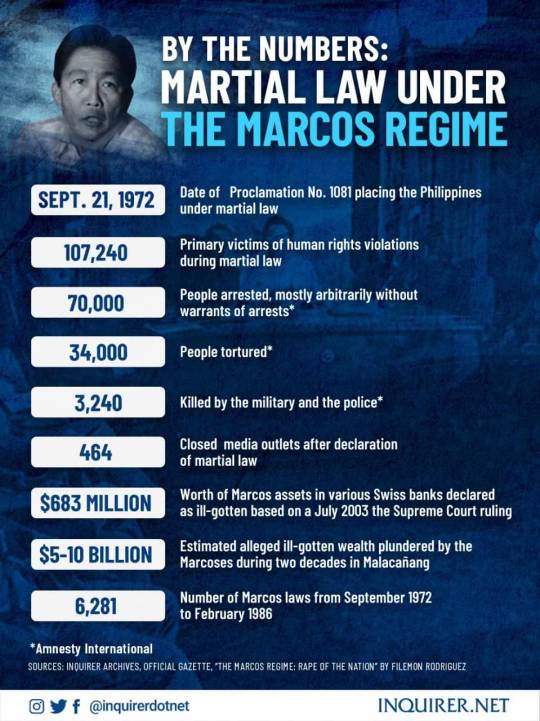
Data from the image:
Sept. 21, 1972: Date of Proclamation No. 1081 placing the Philippines under martial law.
49: Persons from the Greater Manila Area immediately arrested on Sept. 22, 1972, by the military, among them three senators, three congressmen, two provincial governors, four delegates to the Constitutional Convention and eight newsmen. First on the list was opposition senator and main political rival Benigno “Ninoy” Aquino Jr.
Sept. 23, 1972: Press Secretary Francisco Tatad announces the imposition of martial law and reads the Marcos proclamation in a nationwide televised broadcast. Marcos himself went on air at 7 p.m. to formally announce the proclamation
12-4 a.m. – Curfew was put in place
Jan. 17, 1981: Marcos signs Proclamation No. 2045 lifting the implementation of martial law ahead of the first papal visit of Pope John Paul II in February.
107,240: Primary victims of human rights violations during martial law
70,000 people arrested, mostly arbitrarily without warrants of arrests*
34,000 people tortured*
3,240 killed by the military and the police*
*Amnesty International
464: Closed media outlets after declaration of martial law
$683 million: Worth of Marcos assets in various Swiss banks declared as ill-gotten based on a July 2003 the Supreme Court ruling
$5-10 billion: Estimated alleged ill-gotten wealth plundered by the Marcoses during two decades in Malacañang
6,281: Number of Marcos laws from September 1972 to February 1986
2,036 presidential decrees
61 general orders
1,093 executive orders
1,409 proclamations and other issuances
1,525 letters of instructions
157 letters of implementation
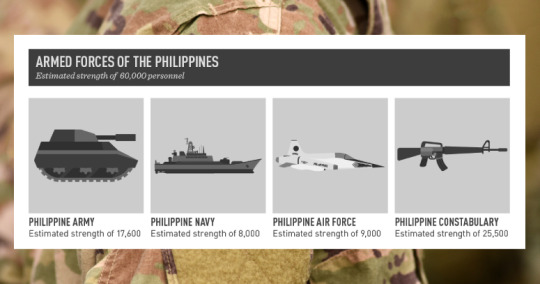
Info from image:
Military Power
By the time martial law was in effect, the Philippine Army had an estimated strength of 17,600; the Philippine Navy with 8,000; Philippine Air Force with 9,000; and the Philippine Constabulary with 25,500.

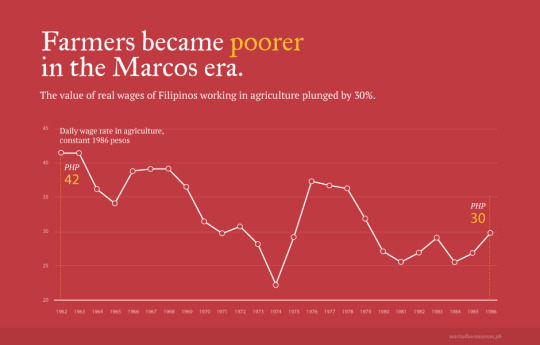

Info from images:
Poverty
Poverty worsened over the course of the Marcos era. Whereas about 4 out of 10 families were poor before Marcos took office, 6 out of 10 families were poor by the end of his rule.
Moreover, as the graph on the left shows, this is a consistent trend across the different regions of the nation, with some regions reaching as high a rate as 7 out of 10 families below the poverty line. Only two regions saw a marginal decrease in the number of poor families: the Ilocos Region and Cagayan Valley.
Daily wages of Filipino agricultural workers declined by about 30%, such that if a farmer earned Php 42 per day in 1972, he would only be earning about Php 30 in 1986. The wages of farmers even went as low as nearly half of the pre-Marcos values in 1974, right after the declaration of Martial Law (middle graph).
On the other hand, for skilled and unskilled workers in urban areas, the graph on the right shows the change in their wages from pre-Marcos to EDSA values. Skilled workers are workers with some special knowledge or skill, often having gone to college or technical school; unskilled workers are workers without this level of training.

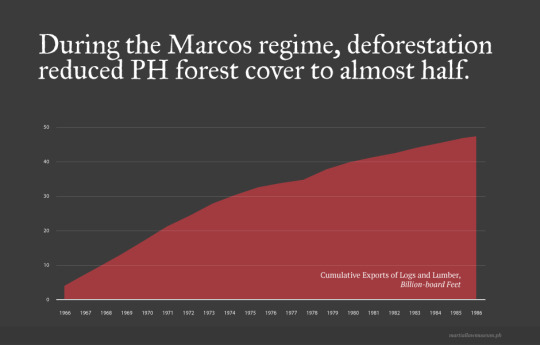
Info for images:
Deforestation
In addition to factors relating to the domestic economy, another way of assessing the Marcos regime is through its impacts on the nation’s natural resources and the environment. The graph specifically gives us an idea about how Marcos’s policies affected the country’s forest cover over the course of about 20 years.
Supposedly, about 90% of the Philippines’ 18.7 million hectares of uplands, including more than 11 million hectares officially classified as timberlands, is publicly owned. In practice, fewer than 200 individuals controlled a large fraction of the country’s forests.
In pursuit of economic gains, Marcos and his cronies’ uncontrolled exportation of timber led to a drastic reduction in forest cover. This cascades into dire environmental impacts including flooding, landslides, and even the worldwide phenomenon of global warming.
I could add more to this post, but that would be way too long.
To this day, the Marcos family, their allies, and supporters, paid or not, continue to deny these facts and claim that the Marcos family were good for the Filipino people and the country.
We must continue to remind the people of this dark time in the history, to not let history be erased and be replaced with lies, to remember the sacrifices made by the victims of Martial Law and their families, and to not let history repeat itself.
Never Forget!
Never Again!
sources:
https://philstarlife.com/news-and-views/649814-martial-law-by-the-numbers?page=6
https://martiallawmuseum.ph/magaral/martial-law-in-data/
https://newsinfo.inquirer.net/1167808/fast-facts-the-marcos-martial-law-regime
The Martial Law Museum and the Bantayog ng mga Bayani sites are good places to start reading more about this.
#Feel free to add more to this post bc i know theres way more#martial law#martial law anniversary#marcos#ferdinand marcos sr#philippines#philippine politics#bbm#bongbong marcos#ph politics#ph#ph history#history#politics#human rights#environment#historical revisionism#revisionism
25 notes
·
View notes
Text
“Northern states acted separately to end slavery. Vermont was the first state to forbid it by incorporating an antislavery provision into its 1777 constitution. In Massachusetts the courts abolished slavery in a series of ‘freedom cases’ brought by slaves and their sympathizers in the 1780s. As Chief Justice William Cushing of the Supreme Judicial Court ruled, ‘The idea of slavery is inconsistent with our own conduct and constitution. …there can be no such thing as perpetual servitude of a rational creature.’ New Hampshire adopted a constitution in 1783 that declared ‘all men are born equal and independent.’
…Elsewhere the process of freeing the enslaved was painfully slow. State legislatures enacted gradual abolition statutes in Pennsylvania (1780), Rhode Island (1784), Connecticut (1784), New York (1799), and New Jersey (1804). These laws provided for freedom of the children of slaves when they reached ages ranging from 18 to 28. In this way, parents who were enslaved for life saw their children become free. Their victory must have been bittersweet, filled with boy joy and agonizing frustration. As late as 1840, New Jersey still listed legally owned slaves on its census.
…Freedom did not, however, change the daunting work responsibilities of black women. They remained largely an unskilled work force. Under the southern slave system, women worked almost exclusively as agricultural laborers. A few found employment as domestics, and on rare occasion (especially during the war years) women worked at skilled tasks, such as spinning and weaving. But many more black men than women worked at skilled trades under slavery. …Most black women in towns and cities worked as laundresses. As the Pennsylvania Abolition Society reported in 1795, ‘The Women generally, both married and single, wash clothes for a living.’ This physically demanding job was no easier than fieldwork. Whatever their occupation, under both slavery and freedom women worked from dawn to dusk to support themselves and their families.
…In all urban centers blacks moved gradually into their own neighborhoods. At first they sought simple companionship, the opportunity to live among people who did not judge them as inferiors. Soon, however, they were establishing churches, schools, and charitable societies to help each other in their daily struggles for survival. Life in the urban North was difficult for black families, but for those who could live where they wanted and with whom they wanted for the first time, freedom made the daily struggle to survive worthwhile.
…The rise of a large free black population in the North aggravated racial tensions in both the North and South. White northerners no longer wanted to uphold a slave system, but for the most part their attitudes toward the newly freed slaves did not change. Racist feelings of superiority determined the treatment of blacks under both slavery and freedom. And as slavery became even more firmly entrenched in the South, explicitly racist arguments in favor of the institution were heard more and more. White southerners argued that blacks were intellectually incapable of caring for themselves and their families. They claimed that blacks were inherently lazy, dishonest, and foolish.
…With the end of legal slave importation in sight, the role of enslaved women as childbearers took on new importance. By the end of the 18th century slave owners understood that their slaves’ fertility increased their wealth and guaranteed the continued prosperity of their children. As Thomas Jefferson remarked, ‘I consider a woman who brings a child every two years as more profitable than the best man of the farm.’ This attitude became particularly prevalent in Maryland, Delaware, and Virginia, where planters began to encourage slaves to have large families as a way of making money.
…In other cases, white men coerced their female slaves into reproducing. Some women found themselves coupled with a man unwillingly, simply because the master said it was time for them to produce children. Many owners even raped their own slaves or forced them to become their mistresses. Tragically, most of these men later turned the offspring from these unions into slaves. The social system of the southern colonies and states frowned on men who acknowledged their sexual liaisons by granting freedom to their children. Even the slave owners who promoted stable family life took little trouble to ensure that families stayed together.
…Although some women practiced abortion and infanticide to deny owners additional human property, many more bore children as a means of self-affirmation. In African-American culture, as in the traditional societies of West Africa from which these people came, motherhood gave women personal fulfillment and high social status. As wives and mothers, they satisfied their own needs and the needs of black slave communities even more than the needs of owners. Enslaved families, however tortured, produced the means for individual slave survival.
Just as African-American women struggled to defend their families under slavery, Native American women attempted to protect their families from total destruction during the revolutionary era. The war was very hard on the eastern tribes, which suffered attacks from both English and Patriot troops. Some Indians tried to stay neutral, but the stance proved impossible to maintain. And no matter which side a tribe joined in the war, the enemy loomed near.
…Although the Iroquois survived, their culture, in many wars, did not. Peace found the Iroquois crowded on relatively small reservations, unable to follow the customs of the hunt, migration of town sites, warfare, and family relationships. As a people, they now questioned the validity of their traditions because they had fared so badly in their contests with Europeans. Many Iroquois came to despise their own culture as an inferior one without a place in a new world order.
Reservation life changed many aspects of Indian behavior. One important shift occurred in the division of labor between women and men. On reservations, men’s traditional labor--hunting and warfare--lost significance. Men continued to hunt, but game was scarce and became more so as the years passed. The men usually were able to provide their families with meat, but they no longer traded in furs. In addition, accepting peace on white men’s terms meant that warriors were acknowledging their inability to defend their families. As a result, political and religious leaders, as well as the warriors themselves, suffered greatly from shame.”
- Marylynn Salmon, “The Limits of Republicanism: Racial Conflicts in the North, South, and West.” in The Limits of Independence: American Women, 1760-1800
6 notes
·
View notes
Text
WASHINGTON — The Supreme Court on Thursday rejected a challenge to a California animal welfare law that would ban the sale of pork derived from breeding pigs housed in confined spaces.
You want some good Supreme Court news for a change?
SCOTUS just affirmed California's right to regulate how pigs are farmed for pork products sold in California. Basically: only "humane" methods may be used.
Which is HUGE because there's virtually no pig farming in California.
Most of California's bacon & ham comes from other states, which squealed in terror at the new law because it's expensive as heck to humanely do anything. So the National Pork Producers Council sued California over the bill and it ended up at the Supreme Court.
And now pigs intended for use in California must be raised & slaughtered humanly, yayyy.
BUT THAT'S NOT THE SUPER IMPORTANT BIT
If instead, SCOTUS had ruled the other way? That would have opened the door to negate all California import requirements.
Requirements like: automobile emissions.
See, because California has the strictest vehicle pollution standards in the nation AND import so many vehicles, they've almost single handedly forced the world to make cleaner cars.
Car makers used to either (1) not sell cars in California or (2) build special versions of the same car with better emissions equipment in order to meet the requirements. But they stopped doing that because it's cheaper to just make better fucking cars across the board. Kind of like how they discovered it's cheaper to just put power windows on every car than to switch back and forth between installing buttons & window cranks at the factory.
And everybody won: our air got cleaner.
So SCOTUS actually did the right thing for once. Shocking, right?
21 notes
·
View notes
Text
"Today the United States Supreme Court overthrew the central premise of American democracy: that no one is above the law. "
"We hold these truths to be self-evident, that all men are created equal..." [Declaration of Independence]
"All animals are equal, but some are more equal than others." [Animal Farm]
#SCOTUS#SCOTUS has amended the Constitution#SCOTUS has overthrown the central principle of American democracy#if he is elected there is nothing he can't do#first they came for the...#vote blue
6 notes
·
View notes
Text
This day in history
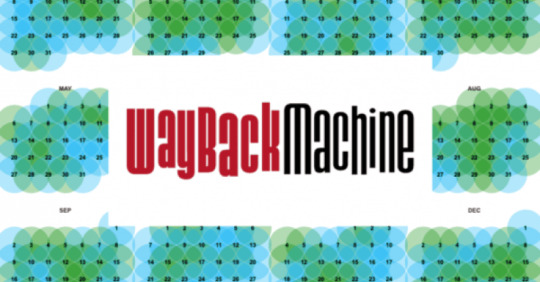
I’m kickstarting the audiobook for “The Internet Con: How To Seize the Means of Computation,” a Big Tech disassembly manual to disenshittify the web and bring back the old, good internet. It’s a DRM-free book, which means Audible won’t carry it, so this crowdfunder is essential. Back now to get the audio, Verso hardcover and ebook:
http://seizethemeansofcomputation.org

#15yrsago World of Developmentcraft: academic paper on gold farming as a development activity in poor countries https://www.salon.com/2008/08/07/gold_farming_global_economy/
#15yrsago California Supreme Court: Non-compete clauses are not enforceable https://workforce.com/news/non-compete-agreements-going-going-gone
#15yrsago Pacemakers can be remotely pwned https://venturebeat.com/security/defcon-excuse-me-while-i-turn-off-your-pacemaker/
#15yrsago Working Medeco high-security keys can be whittled out of plastic https://www.wired.com/2008/08/medeco-locks-cr/
#10yrsago HOWTO bake nested, hemispherical cakes https://cakecrumbs.me/2013/08/01/spherical-concentric-layer-cake-tutorial/
#10yrsago Audiobook memoir of Disney Imagineering legend Rolly Crump: More Cute Stories https://itskindofacutestory.com/?p=102
#10yrsago US businesses stand to lose up to $35B as a result of PRISM https://www2.itif.org/2013-cloud-computing-costs.pdf
#10yrsago Spectacular Haunted Mansion re-creation with Rollercoaster Tycoon https://thedisneyblog.com/2013/08/08/haunted-mansion-recreated-in-roller-coaster-tycoon/
#10yrsago Knitting as computation https://web.archive.org/web/20130810104616/http://www.k2g2.org/blog:bit.craft:computational_model_of_knitting
#10yrsago Standards bodies explain why they think the law should be copyrighted and paywalled https://www.washingtonpost.com/news/wonk/wp/2013/08/07/should-legal-codes-be-copyrighted-lets-sue-to-find-out/
#10yrsago Bill to cut off funding to schools that ban brandishing a pastry in a gun-like manner http://www.loweringthebar.net/2013/08/bill-would-protect-students-right-to-carry-pastry-guns.html
#10yrsago Crooks rip off nonprofit rape crisis center, then return the stuff with an apology note https://www.scientificamerican.com/article/stolen-computers-arrive-back-at-non-2013-08/
#5yrsago Leaked Facebook memo reveals “psychological trick” developed to entice high-school students to sign on https://www.buzzfeednews.com/article/ryanmac/facebooks-teens-tbh-psychological-trick-memo
#5yrsago Here’s the report that showed the FCC lied about being hacked and then lied about lying https://drive.google.com/file/d/1uPl5NsbXowzbXrYf9KHBp-GVilTLQqyW
#5yrsago Inside the triumphant Alex Jones banned everywhere story is a worrying nuance about free speech and platform dominance https://memex.craphound.com/2018/08/08/inside-the-triumphant-alex-jones-banned-everywhere-story-is-a-worrying-nuance-about-free-speech-and-platform-dominance/
#5yrsago There’s something eerie about bots that teach themselves to cheat https://www.wired.com/story/when-bots-teach-themselves-to-cheat/
#5yrsago Japanese self-sharpening mechanical pencils give the lead a tiny turn every time you lift the tip https://www.youtube.com/watch?v=H_OXoxymeho
#5yrsago Young doctors revolt, force AMA to consider backing single-payer healthcare for the first time https://kffhealthnews.org/news/once-its-greatest-foes-doctors-are-embracing-single-payer/
#5yrsago A machine learning system trained on scholarly journals could correct Wikipedia’s gendered under-representation problem https://www.wired.com/story/using-artificial-intelligence-to-fix-wikipedias-gender-problem/
#5yrsago 12% of music industry revenues go to musicians https://consequence.net/2018/08/musician-12-percent-43-billion-revenue/
#5yrsago Facebook throws an extra $10m at Zuck’s personal security https://www.bloomberg.com/news/articles/2018-08-02/protecting-mark-zuckerberg-just-got-more-expensive-for-facebook
#1yrago So You’ve Decided to Unfollow Me https://pluralistic.net/2022/08/08/locus-of-individuation/#publish-then-filter


Back my anti-enshittification Kickstarter here!
15 notes
·
View notes
Text
Some theories about Empires SMP Season 2
There are some things I noticed and wanted to point out:
The episode which was included into Sausage’s Ep. 41 of Empires SMP Season 2 in which he wanted to sue Jimmy for killing him and Fwhip decided to become his lawyer in case of legal court trial and then put a sign “Must be this tall to not be evil” to denote that Jimmy really is evil, was shot while Jimmy was streaming, so it probably can’t be count as a part of real Empires SMP Season two lore.
What about the law: “Murder is fine as long as it’s funny.” written in the Law-Lore Book? (Sausage laughed!)
There is a possibility, that Sausage tried to make Jimmy remember actions of first Season, bringing other members of Wither Rose alliance with him to the bridge, or that this Sausage isn’t even Sausage we know and is in fact Sausage Supreme in disguise. We can’t see his eyes at that moment because of the glasses, so they can be red. Moreover, looking back, we can see, that the introduction of Xornoth caused some disruption in the alliance, and Sausage at one point started working alongside Xornoth, so it could be just a part of his plan to get even with the King of Sanctuary. Supreme came into Empires Season 2, putting our Sausage into some other (possibly random) dimension, where there is no Sanctuary, as shown in his stream “A Tour of Sanctuary”. (The Chances are low, but it can be so)
Gem’s actions can count as impulsive, she never really interacted with/disrespected the Sheriff.
In Sausage’s Ep. 41 the wither rose was shown (last couple of seconds) accompanied with evil laughing which also shows that the real villain of the season might really not be Jimmy (it is also possible that there’ll be more than one villain, but still). • So you can see the same things differently and even though Jimmy said (on his stream: “World Tour With The Old Sheriff”) that he is going to get all of the gunpowder he possibly can (and there really is not a lot in his farm as shown in a part of Lizzie's episode "The Gunpowder Plot") and make as much TNT as he can to blow up all of the Empires (which makes it look similar to the situation that happened in the first season of Empires), but it doesn’t necessarily mean that he is planning to do it and that he is going to have a real villain arc. He might be just teasing us, or we may get a couple of episodes, but I’m not sure that he’ll be able to harm anybody and pull out the villain arc, for he is quite clumsy and can’t do anything right, or just as it was planned and others just make fun of him for that. • Also Joel may stand up for Jimmy, or just help him to calm down, for he can be responsible and wise if needed, and now is in alliance with Jimmy. • The real problem is the Pandora’s Box of the server – the Old Sheriff, who spoils everything and it is hard to understand – purposely or not. He makes Jimmy do crazy things, for he is easily convinced and others just like him for his easygoing charismatic character. (Fwhip, I think, just tries to manipulate the manipulator (the Old Sheriff) to manipulate Jimmy, to get everything back to normal, to how everything was before Jimmy fired him.) The Old Sheriff also can turn out to be the villain of the story. • And the last thing is that all of it can turn out to be a dream (probably Jimmy’s, and most likely – nightmare) of what can happen if he chooses the wrong road. (Something like that happened to Shelby, when she thought that all of her friends turned into zombies in Ep. 12 “I Started A Zombie Apocalypse On Empires!”).
We’ll see how it really turns out.
#empires smp#empires smp season 2#empires smp season two#esmp s2#esmp season 2#empires jimmy#empires solidarity#jimmy solidarity#solidarity gaming#solidaritygaming#toy jimmy#toy sheriff#empires sausage#mythical j sausage#mythical sausage#esmp sausage#mythicalsausage#esmp gem#empires gem#geminitay#empires joel#esmp joel#empires smallishbeans#smallishbeans#joel smallishbeans#empires 2#shubble#empires smp shubble#esmp shubble#witch shelby
22 notes
·
View notes
Text
Excerpt from this Chicago Tribune story:
John Gilbert’s father spent years trying to convert a flood-prone patch of land on their nearly 800-acre farm in Hardin County, Iowa, to more cropland.
“We fought with that land for many years,” said Gilbert, now in his mid-70s. But it was always only a matter of time before heavy rain made it impossible to grow crops. “Some land just isn’t meant to be farmed.”
The Gilbert family stopped fighting nature in the 1990s, shortly after the introduction of the Wetland Conservation provisions in the 1985 Farm Bill. Known as Swampbuster, the federal program requires farmers to conserve wetlands to be eligible for federal farm subsidies, loans and insurance.
The voluntary program encourages Gilbert and many farmers across the country to preserve ecosystems that act as natural flood controls, water quality managers and habitats for native species. His family converted the patch back to grassland and uses it to graze cattle, a move that has improved soil health and mitigated flooding in the long term.
But a federal lawsuit brought before a district court in Iowa by a Chicago investor and two libertarian law firms based in Texas and California in April aims to abolish Swampbuster. It’s one of the federal government’s last mechanisms to safeguard wetlands, whose protections have been severely curtailed over the last decade by the first Trump administration and conservative Supreme Court justices just as climate change makes them more necessary.
Thirty million acres of unprotected wetlands in the upper Midwest, including over 640,000 in Iowa and 1 million in Illinois, are at risk of being destroyed, according to a new study by the Union of Concerned Scientists. These same wetlands provide nearly $23 billion in annual flood mitigation benefits and have the potential to provide hundreds of billions of dollars of mitigation benefits as climate change increases precipitation across the region.
“People who aren’t familiar with the case think this just has to do with Iowa. But it’s a nationwide case that would have nationwide consequences,” said Katie Garvey, an attorney at the Chicago-based Environmental Law and Policy Center. “It would basically get rid of one of the only remaining levels of federal protections of wetlands.”
Garvey is representing Gilbert and fellow members of the Iowa Farmers Union who formally entered the case as intervenors earlier this month. It marks the first time farmers directly implicated in the lawsuit will be involved.
Gilbert already expects to lose 10% to 20% of his planted acres to flooding every year, in part due to upstream farmers who’ve drained their wetlands.
The lower court is expected to decide the case by mid-2025, and both sides are prepared to appeal it to the Supreme Court.
The Pacific Legal Foundation, the California-based firm representing the plaintiff, already successfully argued a case before the Supreme Court last year that upended federal protections for wetlands under the Clean Water Act.
All five conservative justices agreed that the federal government’s definition of wetlands was too broad in Sackett v. EPA, allowing it to unduly impose restrictions on land use in the name of environmental protection. The decision largely left it up to states to decide whether wetlands could be drained and developed.
Environmental advocates say this makes the voluntary Swampbuster program all the more important, while libertarians believe it’s all the more reason to abolish it.
9 notes
·
View notes